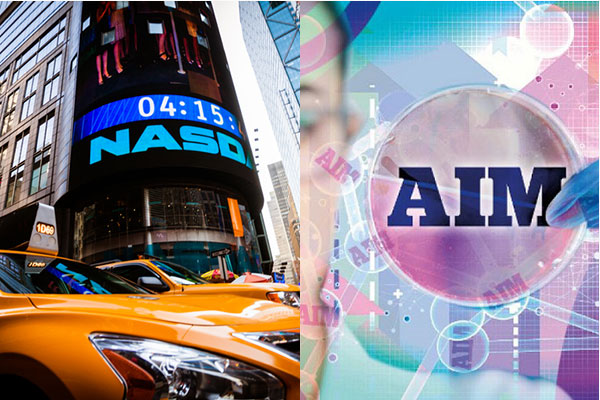Nasdaq vs AIM: key trends, performance and income
6th May 2022 15:57
by Andrew Hore from interactive investor
Both these growth markets have had a terrible 2022 so far, but award-winning AIM expert Andrew Hore identifies the big themes and some stocks that may outperform.

Nasdaq has consistently been the best-performing global market over the years, yet so far in 2022 it has fallen by around one-fifth. Russia has fallen by more but outperforming that market is not much of a relief. The only other major exchanges that are doing as badly as Nasdaq are Shanghai and AIM.
The Bovespa Stock Index in Brazil and the FTSE 100 index are the two major market indexes that have risen this year. BP and Shell have benefited from soaring oil prices and, because of their size, have been two of the bigger contributors to the FTSE 100 outperformance.
Even the wider measures of the Main Market in London show it is a much better performer than the other main European and US markets, yet AIM is not. In fact, although the FTSE AIM All-Share index is around 18% lower this year, the FTSE AIM 100 index has fallen by around 21%.
- Invest with ii: Most-traded US Stocks | Top UK Shares | Open a Trading Account
There have been periods when AIM has outperformed Nasdaq, but generally the growth for Nasdaq has been much greater than for AIM. In reality, Nasdaq companies are much bigger than those on AIM. The 10 smallest companies in the Nasdaq 100 index are worth more than the whole of AIM. Apple (NASDAQ:AAPL), the largest Nasdaq company, is more than 15 times the size of the entire AIM market.
Nasdaq and big tech
The Nasdaq Composite index and Nasdaq 100 index have fallen by the same percentages this year. The weighting of the companies in the Nasdaq Composite will be dominated by the Nasdaq 100 constituents.
Eleven Nasdaq 100 shares have risen, among them pharmaceuticals, food and drinks and electricity companies. Activision Blizzard (NASDAQ:ATVI) is the only software company. All these companies are profitable, including hotels operator Marriott International (NASDAQ:MAR), which returned to profit in 2021.
The larger fallers in the Nasdaq 100 are dominated by software and technology. The top 10 companies by market capitalisation are even more dominated by software and technology, especially if electric car manufacturer Tesla (NASDAQ:TSLA) and Amazon (NASDAQ:AMZN) are included, and they have all fallen. There are two classes of Google shares in the top 10.
The 10th largest company is soft drinks and food company PepsiCo (NASDAQ:PEP), which is also the best performer of these companies with a decline of less than 1%.
- AIM’s best sector in a bad year for junior market
- Read more AIM articles by Andrew Hore here
- Tech crash: three big stocks to buy, hold and sell
By far the worst performer in the Nasdaq 100 is Netflix (NASDAQ:NFLX), which has fallen by more than two-thirds. The market capitalisation of the entertainment streaming company has fallen below $90 billion, which means that it is no longer in the top 30 companies by size. However, before the decline it could have been nearer to the top 10 – even allowing for the share price declines of the companies that are currently larger. It was certainly bigger than PepsiCo at the beginning of the year.
Other poor performers include vaccines developer Moderna (NASDAQ:MRNA), which had been one of the better performers during 2021 with a 143% increase. Lucid (NASDAQ:LCID), which is an electric vehicle technology developer, has halved so far this year, having been the best performer in 2021 with a 280% gain.
However, five of the bottom 10 share performers fell during 2021, so it is not necessarily the better performers from last year that are falling the most.
The Nasdaq 100 rose by nearly 27% in 2021. Seven out of the top 10 companies by market value outperformed the index in 2021.
AIM – big is beautiful
There is a wider range of companies on AIM than there is on Nasdaq, which is more technology and pharma-focused. There are resources companies on Nasdaq, but they are not as well represented as on AIM - although many of them are small.
Larger, profitable companies are currently outperforming smaller ones because they are perceived to be a safer haven in uncertain times. That should be in Nasdaq’s favour when compared with AIM, but the broader sector spread of AIM constituents appears to be offsetting that.
Seventeen AIM 100 shares have risen during 2022 and the top four are resources companies. Three are oil and gas – Pantheon Resources (LSE:PANR), North Sea-focused Serica Energy (LSE:SQZ) and PetroTal (LSE:PTAL) - and one miner – Pan African Resources (LSE:PAF). Pantheon Resources is an oil explorer in Alaska, while the other three are profitable producers and set to be highly cash generative given higher prices. Rising oil and commodity prices have also boosted the share prices of Jadestone Energy (LSE:JSE), uranium investor Yellow Cake (LSE:YCA), palm oil producer M P Evans (LSE:MPE) and oil and gas company Kistos (LSE:KIST).
There is more of a mixture of industries covered by the worst performers. Some like legal services provider Knights Group Holdings (LSE:KGH) and Victorian Plumbing (LSE:VIC) have been hit hard by profit warnings. Others are unprofitable or were trading on heady multiples. Renewables-focused investment manager Impax Asset Management (LSE:IPX) has fallen on the back of the stock market decline added to by the slump in share price of some cleantech and renewables companies that had high valuations without any fundamentals.

Investing for income
The FTSE AIM 50 UK index has done slightly better than the other AIM measures. That may be partly due to the fact that two-thirds of the constituents pay dividends, which is a higher proportion than for the other measures. There are around 200 dividend payers on AIM, which is less than one-quarter of the total number of companies.
Taking AIM as a whole, there are 250 companies with higher share prices so far in 2022, with 27 out of the best performing 30 companies and 42 out of the top 50 being oil and gas or mining companies. Many of them are tiny and some are speculative because they do not have production.
Oil and gas companies with production, and therefore strong cash generation on the back of price rises, appear to be some of the most attractive smaller companies at the moment.
- Richard Beddard: it’s worth paying up for this small-cap share
- AIM stocks Q1 stats: market crumples in face of global tensions
- From AIM to Main: does moving markets make sense?
There are other AIM companies where share prices may not have risen by much, but they are significantly outperforming the junior market. Index-linked income is attractive. Smart Metering Systems (LSE:SMS) has index-linked income from the management of metering assets. This enables Smart Metering Systems to promise an annual 10% increase in dividends. The yield is 3.3%, but this will increase significantly over the years.
Renewable electricity generator Greencoat Renewables (LSE:GRP) invests in wind farms and solar, predominantly in Ireland. More recently, investments have been made in offshore wind in Germany and solar in Spain. These assets tend to have multi-year electricity sales agreements with longer-term floor electricity prices.
The Ireland-based company has one of the highest sustainable yields on AIM. The current yield is 5.2% and the dividend has been consistent in the past couple of years. The latest quarterly dividend was increased from €0.0152 a share to €0.0154 a share – the first quarterly increase for two years. The dividend will vary with the exchange rate for investors paid in sterling.
Growth and risk
There are companies that continue to grow. CentralNic (LSE:CNIC) forecast profit has already been upgraded more than once this year, yet the share price has fallen. The forecast multiple for the company has fallen below 12. Organic growth in earnings is expected to be in double digits in the following two years and cash generation is impressive.
Marketing services provider Next Fifteen Communications (LSE:NFC) is another company that continues to beat expectations. The share price has slipped after more than doubling last year.
Riskier small companies may continue to find it tough. Those that do not have positive news flow are liable to remain depressed or drift lower. Disappointments will lead to sharp reductions in share prices. If there are positive announcements that show progress, then share prices can move higher.
Green hydrogen production developer Atome Energy (LSE:ATOM), which was spun out of President Energy (LSE:PPC) at the end of 2021, drifted lower until the end of February. Ordering the first electrolyser and a major 60MW power purchase agreement with ANDE, the national power supplier in Paraguay, indicate that this hydrogen and ammonia project is progressing even faster than expected. Hydrogen production could commence in Paraguay in the first quarter of 2023. There is another project in Iceland and news about this project could provide further impetus for the share price.
There could be further recovery to come from businesses most severely hit by lockdowns, such as airline and tour operator Jet2 (LSE:JET2) and attractions operator Brighton Pier Group (LSE:PIER), but the VAT reduction for UK leisure companies comes to an end later this year and that could hold back progress.
Disclosure
We use a combination of fundamental and technical analysis in forming our view as to the valuation and prospects of an investment. Where relevant we have set out those particular matters we think are important in the above article, but further detail can be found here.
Please note that our article on this investment should not be considered to be a regular publication.
Details of all recommendations issued by ii during the previous 12-month period can be found here.
ii adheres to a strict code of conduct. Contributors may hold shares or have other interests in companies included in these portfolios, which could create a conflict of interests. Contributors intending to write about any financial instruments in which they have an interest are required to disclose such interest to ii and in the article itself. ii will at all times consider whether such interest impairs the objectivity of the recommendation.
In addition, individuals involved in the production of investment articles are subject to a personal account dealing restriction, which prevents them from placing a transaction in the specified instrument(s) for a period before and for five working days after such publication. This is to avoid personal interests conflicting with the interests of the recipients of those investment articles.
These articles are provided for information purposes only. Occasionally, an opinion about whether to buy or sell a specific investment may be provided by third parties. The content is not intended to be a personal recommendation to buy or sell any financial instrument or product, or to adopt any investment strategy as it is not provided based on an assessment of your investing knowledge and experience, your financial situation or your investment objectives. The value of your investments, and the income derived from them, may go down as well as up. You may not get back all the money that you invest. The investments referred to in this article may not be suitable for all investors, and if in doubt, an investor should seek advice from a qualified investment adviser.
Full performance can be found on the company or index summary page on the interactive investor website. Simply click on the company's or index name highlighted in the article.